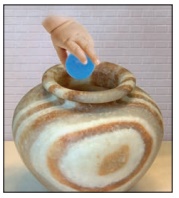Probability | Maths - Classical Approach | 9th Maths : UNIT 9 : Probability
Chapter: 9th Maths : UNIT 9 : Probability
Classical Approach
Classical Approach
The chance of an event happening when expressed quantitatively is
probability.

For example, An urn contains 4 Red balls and 6 Blue balls. You choose a ball at random from
the urn. What is the probability of choosing a Red ball?
The phrase
‘at random’ assures you that each one of the 10 balls has the same chance (that
is, probability) of getting chosen. You may be blindfolded and the balls may be
mixed up for a “fair” experiment. This makes the outcomes “equally likely”.
The probability
that the Red Ball is chosen is 4/10 (You may also give it as 2/5 or 0.4).
What would be the probability for choosing a Blue ball? It is 6/10 (or 3/5 or 0.6).
Note that the sum of the two probabilities is 1. This means that
no other outcome is possible.
The approach
we adopted in the above example is classical. It is calculating a priori probability. (The Latin phrase a priori means ‘without
investigation or sensory experience’). Note that the above treatment
is possible only when the outcomes are equally likely.
Thinking Corner
If the probability of success of an experiment is 0.4, what is the
probability of failure?
Classical
probability is so named, because it was the first type of probability studied formally
by mathematicians during the 17th and 18th centuries.
Let S be
the set of all equally likely outcomes of a random experiment. (S is called the
sample space for the experiment.)
Let E be
some particular outcome or combination of outcomes of an experiment. (E is called
an event.)
The probability
of an event E is denoted as P(E).
P(E) = Number
of favourable outcomes / Total number of outcomes

= n(E)
/ n(S)
The empirical
approach (relative frequency theory) of probability holds that if an experiment
is repeated for an extremely large number of times and a particular outcome occurs
at a percentage of the time, then that particular percentage is close to the probability
of that outcome.
Related Topics